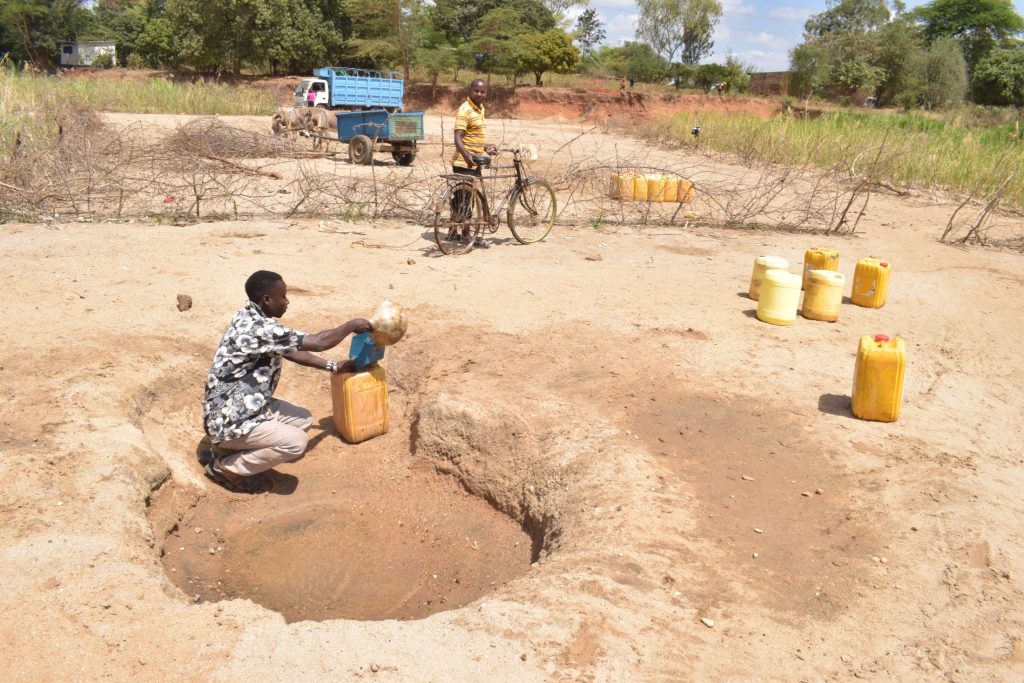Gender in Water-Fetching Culture: Even Within Kenya, It’s Not Always the Same
In Western Kenya, it is the role of women, girls, and children to fetch water. Growing up as a young girl in Kenya, I saw only women and girls fetching water, and not men. We also rarely take the time to understand why fetching water is predominantly considered the “woman’s job” (or that of children). But we were raised differently, and we automatically adapt to the culture that we are used to.
In Western Kenya, women and children do all the house chores and fetch water, no matter how far away the water is. It is also taboo to see a man carrying water, so men won’t help with water-fetching to avoid being seen as weak and not the heads of their families. The men’s role is providing for their families and ensuring that their family is okay, not fetching water. It is very rare to see men carrying water, except for those who carry water on their motorbikes, cars, and carts either for selling or taking to a construction site.
The water sources here in western Kenya are quite close together. Here, the quantity of water is not a problem, but the quality of water is key. Many families are affected by waterborne illnesses, which are quite expensive to treat and, when not treated well, cause death.
Recently, The Water Project’s Regional Director for Western Kenya, Mr. Humphrey Buradi, visited Southeast Kenya along with a few members of the Western Kenya team. For me, it was so interesting to get the Southeast team’s feedback on how communities in Machakos, Makueni, and Kitui counties fetch water. Seeing men fetching and carrying water using oxen-pulled carts, donkeys, and bicycles really stood out for me, and I was eager to know why men participate in fetching water.
Southeastern Kenya is known as being an arid (dry) and semi-arid area because it has longer dry seasons in a year than rainy seasons, which is quite the opposite of Western Kenya, where we receive more rain. Their water sources are many kilometers away from their homes and institutions. For this reason, men have taken the role of fetching water to lessen the burden of women walking for longer distances and, at the same time, looking after children. This is different from many men in Western Kenya.
Historically, Southeast Kenya is known for having water challenges, and the long distances away from water points cause insecurity to women and girls, thus forcing men to take up the role of fetching water.
And the differences don’t stop there. Women in Western Kenya carry water on top of their heads, but in Southeastern Kenya, fetching water often requires a masculine person because they must carry more water per trip. Because of this, they use different fetching methods like donkeys, cow-pulled carts, motorbikes, bicycles, and three-wheeled motorized vehicles called tuk-tuks. These methods really suit men because it requires a lot of energy for one to take water from the well or from the water kiosk to their homes.

Water scarcity is real in Southeast Kenya, which causes high water demand compared to Western Kenya. In Southeast Kenya, it is hard for women to make many trips to fetch water, considering the longer distances and the terrain, which is rocky and dusty and puts women at risk of falling, getting tired, and later being unable to take care of their family’s responsibilities.
Traditionally, it is believed that women and girls are the ones to ensure there is water at home, but this way of thinking is slowly fading away, especially in Southeast Kenya. People in Southeast Kenya were raised in an environment where both boys and girls struggled looking for water at a young age. When they matured to have their own homes and families, both genders fetching water was not a problem because they grew up facing the same challenge, and they have learned to live with it. That is why it is not a problem at all seeing men carrying water, because they share the roles of doing things in their families.
Those of us in Western Kenya and those in Southeast Kenya live in the same country, but have different issues and challenges affecting every community. We might have the same traditions, beliefs, and culture, but when it comes to issues affecting us, it doesn’t matter who ensures the problem is solved. I have learned that water is life, and it doesn’t matter who participates in fetching water, as long as a family has clean water. Both men and women are key to ensuring that every home has water to drink.
As both women and men are key in ensuring that every home has clean water, so are those giving their funds to ensure that we have clean and safe water. Our donors and supporters (like you!) are in our hearts, too.
Home More Like ThisTweet